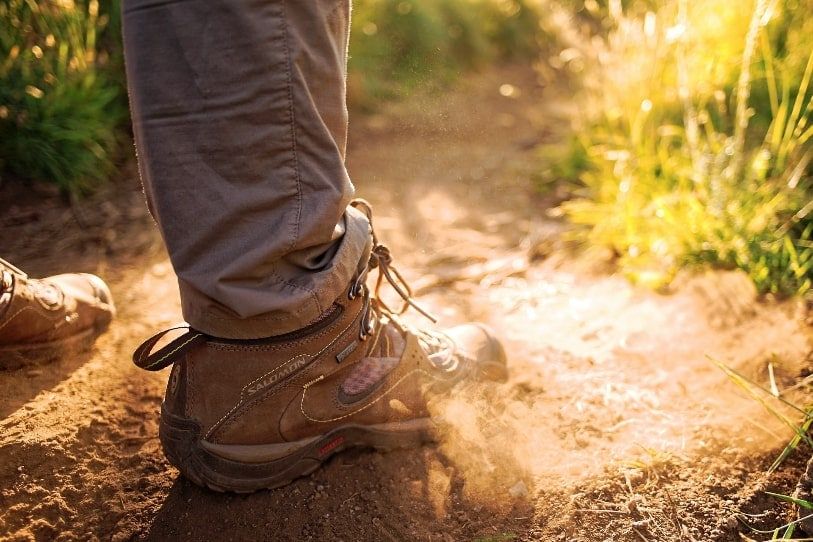Love going hiking but hate getting blisters every time you hit the trail? Blisters, or serum-filled bubbles under the skin, are one of the most common hiking injuries. The good news is that there are steps you can take to prevent them.
What Causes Blisters?
You may already have an idea of how you develop blisters but there are a few of the most common reasons people get them:
- Pressure
- Friction
- Moisture
- Combination of these causes
Whether you have a misplaced sock or haven't broken in your hiking boots, blisters can occur when your skin is not protected. Even moisture from sweating can increase your risk of developing a blister. The good news is that all of these causes can usually be prevented.
Preventing Blisters
When reading about hiking, you'll find a number of guides on how to treat blisters but prevention is always better. If you're not sure of where to get started, these are the time-tested methods that experienced hikers use to prevent blisters from forming.
#1 - Take The Time To Find Shoes & Socks That Fit Properly
Australian Hiker has some good advice for hikers on how to prevent blisters - their key takeaway is focusing on your shoes and socks.
Hiking shoes should be neither too loose or tight. When shopping for hiking shoes, try them out before you purchase. Bring along the socks that you will be using when going hiking to make sure that the shoes are a good fit.
You should also try to go shoe shopping in the afternoon, as your feet tend to swell up over the course of the day, meaning that they are slightly larger in the afternoon compared to the morning.

Speaking of socks, they also play an essential role. Socks need to provide good padding but should not cause your feet to retain sweat and moisture.
Many hiking socks today come with sweat wicking materials which is good, but keep in mind that the weight of your socks may also have an impact. If you tend to notice lots of sweat accumulating, changing to a lightweight hiking sock might be a good move.
#2 - Deal with Hot Spots
The hiking experts at REI know that even good preventative care may not prevent blister formation. However, by paying attention to your feet while hiking, you may be able to stop a blister before it has a chance to form properly.
When you notice an uncomfortable spot on your foot, take off your shoes as soon as possible and take steps to protect the damaged skin.
Companies sell blister kits but you can make your own kit with a few simple items.
Surgical tape or kinesiology tape works well to protect your skin. Blister bandages can also pad the area and reduce any friction. Other hikers swear by moleskin bandages and say that they are the most effective at protecting blister hot spots.
You can find these items at pharmacies or hiking stores so pick up a few and try each of them out to see which one works best for you. Keep them in your backpacking first aid kit so that you won't forget them when you head out.
#3 - Give Your Feet Some Fresh Air
Although it may seem counterintuitive to take off your shoes and socks, giving your feet some time to breathe is a great option.
When you stop for lunch or a decently long break, take off your shoes and socks. Since feet swell while they're hiking, it's a good idea to slightly elevate them and improve recovery. This is also a good time for you to inspect your feet and take note of any developing hot spots or problem areas.

Some hikers also recommend using a mid-hike break to change your socks. If you have room for two pairs and are prone to sweating, then it may be a good idea to change out your socks.
This isn’t always possible (especially if you are doing ultra lightweight trekking and already carrying a hiking tent), but do consider this option if it is a possibility for you.
#4 - Try Powder and Liner Socks
While some hikers may find that the above solutions work well, people with sensitive feet may still experience problems. The Hiking Guy swears by his combined method of dry powder and liner socks. A skin powder can be used to coat your clean, dry feet before hiking. It works to reduce moisture and also prevent friction.
After applying the powder, a pair of liner socks are a good idea. They are thinner than regular socks and come with moisture-wicking properties. You can then put on your normal hiking socks over the top.

#5 - Try Using Hiking Poles
In general, blisters can be prevented by having the appropriate footwear and being mindful of your feet as you hike.
If you think your walking style is what's causing the problem, consider getting some walking poles to better distribute the effort across your body, rather than leaving it all to your feet.
Final Thoughts
The solutions here will keep your feet in good shape even on long hikes.
However, if you're new to hiking, you may want to start with some easier hikes and let your feet adjust over time.
Still have some questions? Make sure to comment below!
This article may contain affiliate links. I will earn a commission if you choose to purchase a product or service after clicking on my link. This helps pay for the cost of running the website. You will not be disadvantaged in any way by using my links.
Note that while every effort is made to ensure the accuracy of the information on this page, there may sometimes be errors. Check all specifications with the manufacturer before purchasing any product.



